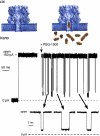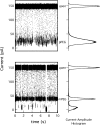Single-molecule mass spectrometry in solution using a solitary nanopore
- PMID: 17494764
- PMCID: PMC1866312
- DOI: 10.1073/pnas.0611085104
Single-molecule mass spectrometry in solution using a solitary nanopore
Abstract
We introduce a two-dimensional method for mass spectrometry in solution that is based on the interaction between a nanometer-scale pore and analytes. As an example, poly(ethylene glycol) molecules that enter a single alpha-hemolysin pore cause distinct mass-dependent conductance states with characteristic mean residence times. The conductance-based mass spectrum clearly resolves the repeat unit of ethylene glycol, and the mean residence time increases monotonically with the poly(ethylene glycol) mass. This technique could prove useful for the real-time characterization of molecules in solution.
Conflict of interest statement
The authors declare no conflict of interest.
Figures





Similar articles
-
Single polymer molecules in a protein nanopore in the limit of a strong polymer-pore attraction.Phys Rev Lett. 2006 Jul 7;97(1):018301. doi: 10.1103/PhysRevLett.97.018301. Epub 2006 Jul 5. Phys Rev Lett. 2006. PMID: 16907416
-
Mechanism of KCl enhancement in detection of nonionic polymers by nanopore sensors.Biophys J. 2008 Dec;95(11):5186-92. doi: 10.1529/biophysj.108.140814. Epub 2008 Sep 19. Biophys J. 2008. PMID: 18805926 Free PMC article.
-
Theory for polymer analysis using nanopore-based single-molecule mass spectrometry.Proc Natl Acad Sci U S A. 2010 Jul 6;107(27):12080-5. doi: 10.1073/pnas.1002194107. Epub 2010 Jun 21. Proc Natl Acad Sci U S A. 2010. PMID: 20566890 Free PMC article.
-
Nanopore analysis of nucleic acids bound to exonucleases and polymerases.Annu Rev Biophys. 2010;39:79-90. doi: 10.1146/annurev.biophys.093008.131250. Annu Rev Biophys. 2010. PMID: 20192777 Review.
-
"Polymeromics": Mass spectrometry based strategies in polymer science toward complete sequencing approaches: a review.Anal Chim Acta. 2014 Jan 15;808:56-69. doi: 10.1016/j.aca.2013.10.027. Epub 2013 Oct 21. Anal Chim Acta. 2014. PMID: 24370093 Review.
Cited by
-
Using a nanopore for single molecule detection and single cell transfection.Analyst. 2012 Jul 7;137(13):3020-7. doi: 10.1039/c2an35571j. Epub 2012 May 29. Analyst. 2012. PMID: 22645737 Free PMC article.
-
Modulation of electrophoresis, electroosmosis and diffusion for electrical transport of proteins through a solid-state nanopore.RSC Adv. 2021 Jul 12;11(39):24398-24409. doi: 10.1039/d1ra03903b. eCollection 2021. RSC Adv. 2021. PMID: 34354824 Free PMC article.
-
Enhanced translocation of single DNA molecules through alpha-hemolysin nanopores by manipulation of internal charge.Proc Natl Acad Sci U S A. 2008 Dec 16;105(50):19720-5. doi: 10.1073/pnas.0808296105. Epub 2008 Dec 5. Proc Natl Acad Sci U S A. 2008. PMID: 19060213 Free PMC article.
-
Programming nanopore ion flow for encoded multiplex microRNA detection.ACS Nano. 2014 Apr 22;8(4):3444-50. doi: 10.1021/nn406339n. Epub 2014 Mar 26. ACS Nano. 2014. PMID: 24654890 Free PMC article.
-
Determination of Molecular Weights in Polyelectrolyte Mixtures Using Polymer Translocation through a Protein Nanopore.ACS Macro Lett. 2014 Sep 16;3(9):911-915. doi: 10.1021/mz500404e. Epub 2014 Sep 2. ACS Macro Lett. 2014. PMID: 25243100 Free PMC article.
References
-
- Coulter WH. US Patent. 2,656,508. 1953.
-
- Ito T, Sun L, Crooks RM. Anal Chem. 2003;75:2399–2406. - PubMed
-
- Saleh OA, Sohn LL. Nano Lett. 2003;3:37–38.
-
- Heins EA, Siwy ZS, Baker LA, Martin CR. Nano Lett. 2005;5:1824–1829. - PubMed
-
- Song LZ, Hobaugh MR, Shustak C, Cheley S, Bayley H, Gouaux JE. Science. 1996;274:1859–1866. - PubMed
Publication types
MeSH terms
Substances
LinkOut - more resources
Full Text Sources
Other Literature Sources
Research Materials

